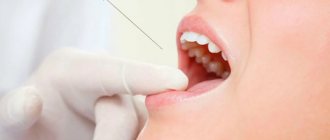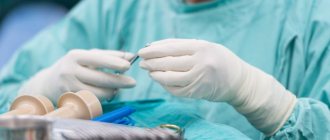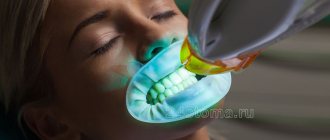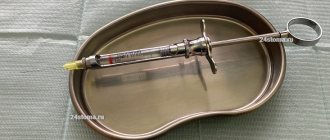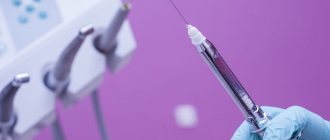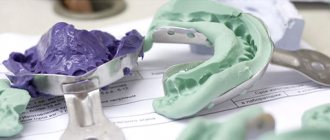From this article you will learn:
- anesthesia in dentistry - drugs,
- types of anesthesia for dental treatment,
- pain relief during pregnancy and breastfeeding.
The article was written by a dental surgeon with more than 19 years of experience.
Local anesthesia is a type of anesthesia, the meaning of which is to block the transmission of pain impulses from the area where the intervention is performed. Options for local anesthesia in dentistry include infiltration, conduction or application anesthesia. They allow you to anesthetize only the area where the intervention is planned (this could be a group of teeth or a fragment of the jaw), while the patient is conscious.
To carry out local anesthesia in dentistry, medications are used that are called “local anesthetics”. But in some cases, for example, during extensive surgical interventions or a person’s panicky fear of treatment or tooth extraction, general anesthesia can also be used, in which, along with pain sensitivity, the patient’s consciousness is temporarily turned off. General anesthesia is performed using narcotic analgesics (administered intravenously or inhaled).
Local anesthesia in dentistry –
The very first local anesthetic in dentistry was novocaine, which, however, did not allow for significant anesthesia and practically did not anesthetize inflamed tissues. Later, lidocaine appeared, which was already about 2-2.5 times stronger in effectiveness, but like novocaine, it did not allow achieving a great depth and duration of anesthesia. A real revolution occurred with the advent of articaine anesthetics (based on articaine hydrochloride), which additionally contained vasoconstrictors.
The most popular local anesthetics in dentistry based on articaine are Ultracaine, Ubistezin, Alfacaine, Septanest and others. To further increase the depth and duration of anesthesia, vasoconstrictors began to be added to these drugs. The latter constrict the blood vessels at the site of injection of the anesthetic, thereby reducing the rate of its leaching from the tissues. Currently, epinephrine is most often used as a vasoconstrictor at a concentration of 1:100,000 and 1:200,000.
Local anesthesia in dentistry: types and preparations
In dentistry, both therapeutic and surgical, different types and techniques of anesthesia are used, for example, conduction, infiltration, intracanal, intraosseous, intraligamentary (intraligamentous), tuberal and others. Their differences lie in the place of application and in some features of their effects. As a rule, modern dental clinics in Moscow use carpule anesthesia. This means that the anesthetic is supplied in disposable carpules - a kind of cartridges with an anesthetic solution that are inserted into syringes with screw-on disposable needles. Due to this, the carpules remain sterile, since the dentist does not have to open them, thereby eliminating contact of the medicine with air.
What to do if you are afraid of anesthesia -
Indeed, an anesthetic injection can be painful. The pain will depend both on the patient’s pain sensitivity threshold and on the doctor’s anesthesia technique. According to the rules, a solution of one anesthetic carpule (1.7 ml) is excreted into the tissue within 40-45 seconds. If the doctor saves time, then it is logical that rapid administration of the solution will cause pain.
To reduce the discomfort from an anesthetic injection, you can ask the doctor to first use a gel or spray with lidocaine to conduct topical anesthesia at the site of the future injection. You can also ask your doctor to administer the anesthetic slowly.
Drugs to relieve fear and anxiety – There are also drugs that can reduce fear and anxiety before an upcoming trip to the dentist. At the same time, there are drugs with a sedative effect such as (Persen forte), and there are drugs only for relieving anxiety, for example, Afobazol. The latter does not have a sedative effect, and it makes sense to start taking it only 10 days before going to the dentist, because... the drug has a cumulative effect (24stoma.ru).
In a number of large clinics, as a premedication, you can also be given an intramuscular injection of diphenhydramine 30 minutes before the start of treatment. You can also use tinctures of valerian, motherwort, Corvalol, valocardine. However, it is also advisable to take these drugs in a course (at least a few days before visiting the doctor), because they also have a cumulative effect. But you need to take into account that these drugs also have a hypnotic effect, which is not very good for motorists and working people.
Conduction anesthesia
Conduction anesthesia is aimed at blocking the nerve through which the pain signal is transmitted. In this way, it is possible to “turn off” a significant area of the jaw associated with the nerve that was exposed to the drug for a fairly long time - from an hour to an hour and a half. As a rule, conduction anesthesia is prescribed if extensive intervention is required on several molars and adjacent soft tissues. With the conduction method, the anesthetic is administered in close proximity to the nerve, and it is very important to correctly calculate this location, since if it is too far from the nerve, pain relief may not occur, and if it gets into the nerve itself, a complication such as neuropathy may develop . According to statistics, neuropathy occurs in 1% of cases and most often completely recedes within a year. By the way, when conducting conduction anesthesia in dentistry under ultrasound guidance, its safety and effectiveness are significantly increased.
Operating principles
Anesthesia is carried out immediately before the start of treatment. The anesthetic comes in both liquid and gel form. The doctor injects into the soft tissues that are located near the diseased tooth. After some time, the tongue, gums and cheeks become numb and “freeze”. At this moment, the anesthetic acts as a blocker of nerve impulses that send a pain signal to the brain. The patient calmly endures dental procedures without experiencing stress.
The duration and effectiveness of dental anesthesia depends on the quality of the materials used and the location of the injection. The closer to the problem area the injection was administered, the more intense its effect. Each organism is individual, therefore the drug will be excreted at different rates.
Different types of drugs function in their own ways. For example, gel-like ones applied to the gums or surface of the cheek last only a couple of minutes. If they are installed in the upper part of the jaw, the effect will last for 2-3 hours. To treat the lower group of teeth, a deeper injection is required, so the result lasts up to 4 hours. After the solution is absorbed, the numbness disappears and sensitivity returns to the patient.
Topical anesthesia in dentistry and drugs
Infiltration or application anesthesia in dentistry is carried out by soaking soft tissues with an anesthetic solution, as a result of which the nerve endings located in the treated area are blocked. With topical anesthesia, the anesthetic is applied without the use of a syringe. Using a cotton swab or your fingers, apply a small amount of the product, which subsequently penetrates approximately 3 mm inside and numbs the selected area. In dentistry, it is used to perform simple and quick operations associated with anesthesia of the oral mucosa, since it lasts, on average, from 10 to (in rare cases) 25 minutes. It is often preceded by subsequent injection anesthesia, especially if the patient is a child or is afraid of injections. There are also preparations for topical anesthesia in the form of aerosols. They are not widely used in dentistry due to difficulties in calculating dosage, as well as easy penetration into the respiratory tract and bloodstream, which increases the risk of complications.
Indications
Most dental procedures are performed under local anesthesia.
Its use is mandatory in the following cases:
- Treatment of pulpitis (first visit)
- Periodontal operations (closed and open curettage, gingivoplasty, elimination of gum recession, guided tissue regeneration)
- Prosthetics of vital (living) teeth with fixed structures (crowns, inlays, onlays, bridges)
- Tooth extraction, implantation, bone tissue augmentation, tooth-preserving operations (apex resection, root amputation, hemisection), making incisions for periostitis, pericoronitis, opening abscesses and phlegmons, removing cysts and tumors
In some situations, anesthesia is mainly used, but patients with reduced sensitivity can do without it:
- Treatment of caries, wedge-shaped defects, non-carious lesions, periodontitis
Procedures that most often do not require anesthesia, but particularly sensitive patients may require:
- Professional oral hygiene
- Restoration of pulpless teeth (both fillings and crowns or inlays)
- Removable prosthetics (if the gag reflex is increased, there may be a need for mucosal anesthesia)
Anesthesia is not recommended:
- Oral examination
- Preventive measures (fluoride varnish applications, fissure sealing)
- Teeth whitening
- Orthodontic treatment
Children often tolerate tooth preparation for caries much easier than an injection into the gum. Therefore, you should not necessarily give an injection on your first visit before starting treatment. It makes more sense to try drilling without anesthesia and switch to it only if the child complains of pain. Compassionate parents, do not worry that your child may experience hellish pain and refuse further treatment. Dentin sensitivity in children is less than in adults. The likelihood of getting psychological trauma from an injection is higher.
Diagnostic local anesthesia is used to identify the diseased tooth. When several adjacent teeth are severely damaged, it is difficult for both the patient and the doctor to determine the source of pulpal pain. In order not to depulpate them all, you can give one anesthesia and wait. If the pain has passed, it should be treated first; if not, anesthetize the next tooth and check the reaction.
Infiltration anesthesia
This is one of the most common methods of anesthesia in modern dentistry. There are two types of infiltration anesthesia: direct and indirect. Direct anesthesia is injected directly under the mucous membrane near the teeth that require treatment, and acts at the injection site. Indirect spreads to surrounding tissues and covers a larger area, while its prevalence depends on the type of surrounding tissues. For example, on the upper jaw the alveolar process is more porous, while on the lower jaw it is denser, which means that the effect of infiltration anesthesia on the upper jaw will be more effective.
Intraligamentary anesthesia
Intraligamentary anesthesia is also called intraligamentous and intraperiodontal. Its difference is in higher pressure when administering an anesthetic, which ensures uniform spreading of a small amount of the drug in the periodontal space, as well as its penetration into the intraosseous space. Drugs should be administered very slowly. When using this type of anesthesia, significantly less drug is required than with conventional infiltration; it occurs within 15-45 seconds and lasts for 20-30 minutes. For intraligamentary anesthesia, special syringes are often used, which make it possible to administer the drug under the required pressure without unnecessary effort and thus achieve the best result.
Coming time
Intrapulpal and intraligamentary anesthesia begins to take effect within a few seconds. Application, infiltration, intraosseous - after 1-5 minutes. Conduction anesthesia is the most variable - from instant pain relief at the same second (if the needle hits the nerve) to half an hour. Sometimes patients, rising from the dental chair after completion of treatment, claim that “only now the freezing has really taken hold.”
Soft tissues are anesthetized before teeth. If the lip or tongue is already “frozen,” the teeth may still remain sensitive, and their premature preparation will be painful.
Intraosseous anesthesia
Intraosseous anesthesia in dentistry is chosen when infiltration or conduction anesthesia is ineffective. It is usually performed in the area of the lower molars and is indicated for treatment, tooth extraction and operations on the alveolar process. However, it is rarely used due to the complex technique of execution: it is necessary to dissect the mucous membrane, then make a hole in the bone with a special bur with a diameter equal to the size of the syringe needle in order to direct the syringe directly to the spongy substance. The drug should be administered slowly, under high pressure.
Among the advantages of this type of anesthesia is significant efficiency; a small amount of even a weak anesthetic is sufficient. Among the disadvantages are the complexity of implementation, as well as serious risks of complications if the drug enters the bloodstream, which is likely due to accidental damage to a vessel.
What are the indications for tooth extraction?
Before tooth extraction surgery, the doctor prescribes an x-ray examination; the resulting images help assess the condition of diseased teeth.
- Detection of chronic periodontitis at the acute stage, when it is impossible to eliminate the source of inflammation in the area of the apex of the tooth using therapeutic methods
- In order to prevent the development of more serious complications
- Diagnosis of basal (near-root) tooth cyst
- Presence of inflammation or trigeminal neuritis
- If a problematic tooth constantly injures the mucous membrane of the tongue or cheeks
- If a tooth puts pressure on adjacent teeth, injuring their roots, which leads to bone resorption
- If a problematic tooth disrupts the normal bite and displaces neighboring teeth
- Multi-rooted teeth that have caused odontogenic osteomyelitis must be removed
- Sometimes the doctor prescribes tooth extraction to fit a removable denture
- With severe destruction by carious lesions
- If the tooth has not fully erupted and has an incorrect angle
- Due to progressive periodontal disease
- Due to an injury that resulted in a tooth fracture beyond repair
- If the teeth are in an incorrect position in the dentition (this situation is often detected during the eruption of wisdom teeth)
Subsequently, the removal of a tooth causes a gradual displacement of adjacent teeth; with prolonged absence of a tooth, this can lead to significant impairment of chewing function and noticeable deformation of the entire dentition. In order to prevent such complications, it is recommended to restore the extracted tooth by replacing it with an artificial one.
Modern dental practice has wide capabilities in the field of operative surgery and implantology, due to which replacing a defect in the dentition by installing a dental implant is the most natural and preferable; depending on the clinical situation, the modern patient has access to the latest technologies for the manufacture of dental bridges or removable partial dentures.
Intracanal anesthesia
The intracanal method of pain relief speaks for itself. Typically, intracanal anesthesia in dentistry is carried out in this way: using a drill, a hole is made in the tooth corresponding to the diameter of the needle, and the drug is injected directly into the pulp or deeper into the canal. Sometimes the carious cavity itself is used for this. If we are talking about the intraligamentary technique, then we mean the introduction of a local anesthetic solution into the space at the root of the tooth (periodontal), and the tuberal technique means the introduction of a substance into the posterior alveolar branches of the upper jaw.
Tuberal anesthesia
Tuberal anesthesia is so named in connection with the injection site - the tubercles of the upper jaw, which are called tuber in Latin. The posterior alveolar nerves are located here, innervating the area of the alveolar ridge from the third to the first molar. This type of anesthesia is the most dangerous in terms of possible complications due to individual differences in the structure of this area and the location of nerves and blood vessels in it. There are intraoral and extraoral methods of administering tuberal anesthesia. It is believed that the intraoral method is more likely to cause injury, while the external method is safer and it is also easier to ensure adequate antiseptic treatment of the surface before injection.
Computer anesthesia
Computer anesthesia allows dentists to calculate more accurate doses of the drug, administer it at the desired speed, pre-selected by the computer, and painlessly guide the syringe needle, which has a special cutting edge. Anesthesia administered with high precision can last longer - up to 40 minutes, and visual and audio signals provided by the device allow the doctor to position the needle as needed, without the risk of tissue damage, introducing anesthetic into the bloodstream or placing the needle too far from the nerve.
Ultrasound anesthesia
When performing anesthesia, it is very important to choose the right injection site, since a mistake can lead to serious complications. This is especially true for conduction anesthesia, where the drug must be in close proximity to the nerve, but the needle cannot touch it. Ultrasound successfully helps determine the site of anesthetic injection. Under the control of an ultrasound machine, it is possible to calculate down to the millimeter the location of the needle and its proximity to the nerve, thereby ensuring the most effective and safe anesthesia of the desired area.
Dosage
The volume of one carpule is 1.7-1.8 ml. This amount is enough for most manipulations within one or two teeth. When treating a larger number of teeth (especially if they are located far from each other), several carpules and injections into different parts of the oral cavity are required.
A second injection of anesthetic into the same place is carried out if the first one is unsuccessful or after some time, when long-term treatment has not yet been completed and the anesthesia begins to wear off. The introduction of the same drug can help if conduction anesthesia is ineffective the first time. With other types of anesthesia, it is necessary to change the anesthetic itself to a more powerful one. It is impossible to increase the volume of the injected solution indefinitely - in case of an overdose, a toxic reaction occurs. For articaine with adrenaline and lidocaine with adrenaline, the maximum dose is 7 mg/kg body weight. One carpule (1.7-1.8 ml) contains 34-36 mg of 2% lidocaine or 68-72 mg of 4% articaine. Therefore, for a person weighing 70 kg, the maximum number of carpules at one time is: 14 for 2% lidocaine and 7 for 4% articaine.
General anesthesia in dentistry
In some cases, the patient may require dental treatment under general anesthesia. As a rule, it is used when serious and long-term treatment is necessary, for example, the removal of several teeth at a time or complex operations on the jaw. An indication for the use of general anesthesia in dentistry may also be serious dental phobia or a disease in which a person cannot adequately communicate with the doctor, or he may have unexpected reactions to the doctor’s actions, as, for example, with epilepsy.
As an alternative to general anesthesia to correct mood and relieve fear of dental treatment, there is sedation in dentistry. It does not “turn off” consciousness, but puts you into half-asleep and calms you down, helps you relax, and perceive what is happening in a positive way. However, sedation is not anesthesia, so it is used in combination with local anesthesia.
General anesthesia
Anesthesia involves the suppression of all human reflexes, including protective ones. The patient completely loses consciousness and falls into deep sleep. Anesthesia can be prescribed only for strict indications and necessarily requires special training of personnel and the dental department as a whole. Despite the fact that in modern medicine, dental treatment under anesthesia has reached a much higher level than before, this procedure is only relatively safe.
There is a risk of negative consequences for the body, which are much higher than the level of risk during the dental procedure itself. In this regard, treatment under anesthesia is indicated only in the most extreme cases, when it is impossible to do without it, for example, in case of dental phobia or serious surgical interventions.
The consequences of anesthesia can be:
- Allergic reactions;
- Anaphylactic shock;
- Cardiac arrest in the presence of chronic diseases;
- Nausea and vomiting after waking up;
- Loss of orientation;
- The recovery of consciousness after anesthesia may be impaired, which, in turn, can even lead to mental disorders.
According to many anesthesiologists, the best anesthesia is the one that the patient refuses.
When is anesthesia used in pediatric dentistry?
Most adults have a fear of dental treatment left over from childhood, so today one of the tasks of a pediatric dentist is to prevent the occurrence of dental phobia or get rid of fears that have already formed in the child. General anesthesia is often the only way to solve dental problems in children under three years of age, as well as in children with developmental disabilities, in particular with autism, Down syndrome, cerebral palsy or epilepsy.
It is not always necessary to carry out dental treatment in children under anesthesia. A small patient who comes to a kind and open doctor will be able to perform most of the manipulations while conscious. The main condition is that these manipulations must be painless. According to some studies, today the most painful procedure for a child is the anesthetic injection itself. That is why in pediatric dentistry, before an injection, topical anesthesia is used, the preparations for which have a pleasant taste, which contributes to a good mood in children and their cooperation with the doctor.
In addition, today in dentistry it is no longer uncommon to have a device for computer anesthesia, which allows painless administration of medicine and clearly measuring its correct dosage.
Modern anesthesia in dentistry: contraindications for use
The main contraindication to anesthesia in dentistry is an allergy to its components; side effects should also be taken into account, which are most often associated with the presence of additional substances in the anesthetic solution: vasoconstrictors, preservatives and stabilizers. In particular, it is necessary to especially carefully select drugs for patients with cardiovascular diseases, arterial hypertension, and decompensated forms of endocrine diseases (diabetes mellitus, thyrotoxicosis, and others). To determine which substances a person has a negative reaction to, the doctor sends him to the Institute of Allergology to perform tests. In accordance with these data, a safe drug for local anesthesia is selected, and in case of reaction to all groups of anesthetics, general anesthesia is used.
Which anesthetic is right for you - summary
- For bronchial asthma or high allergies, an anesthetic without preservatives is needed (usually sodium disulfite is used in anesthetics, which is needed to stabilize epinephrine or adrenaline). Therefore, the anesthetic “Ultracain D”, which does not contain any preservatives, is best suited for such patients.
- If you have thyroid disease or diabetes, in this case you also do not want to use anesthetics containing vasoconstrictor components - adrenaline, epinephrine. The drug of choice, for example, Ultracaine D, Scandonest or Mepivastezin. But, choosing between these three anesthetics, I would give preference to the first.
- If you have high blood pressure and heart disease - with moderate hypertension and compensated heart disease, the optimal choice is anesthetics containing a concentration of epinephrine (adrenaline) - 1:200000. This can be anesthetics “Ultracain DS” or “Ubistezin 1:200000”. In case of severe hypertension, decompensated heart disease, it is necessary to use anesthetics that are completely free of adrenaline and epinephrine. Then, for example, “Ultracain D” will do.
- If you are a healthy person - if you do not have the above diseases, then you can safely administer anesthetics containing epinephrine/adrenaline in a concentration of 1:100,000. Moreover, a person weighing about 70 kg can be given up to 7 carpules of anesthetic inclusive. An example of such anesthetics is Ultracain DS Forte, Ubistezin Forte and analogues.
→ The most powerful analgesics for toothache
What are the features of anesthesia in dentistry for pregnant women?
It is also important for pregnant women to ensure pain-free dental treatment. However, conventional painkillers are not suitable for them, since vasoconstrictors (also known as vasoconstrictors) are usually added to the anesthetic solution in order to keep it in the right place and prolong its effect. Vasoconstrictors also reduce potential common side effects and reduce bleeding. For example, adrenaline added to a four percent solution of articaine can extend its analgesic effect from three to forty-five minutes.
Only mepivacaine can be used without adrenaline, since, unlike other drugs for local anesthesia used in dentistry (articaine, which is considered the best option today, novocaine and lidocaine), it does not have the ability to dilate blood vessels at the injection site, which means it can be recommended for pregnant women, children, and other categories of patients who should not be administered adrenaline. These include, for example, those suffering from cardiovascular diseases, arterial hypertension, severe forms of diabetes mellitus, and severe thyrotoxicosis.
GBUZ LO "Tosnenskaya Clinical Interdistrict Hospital"
Pain during dental procedures is perceived by patients as a lack of professionalism or a dismissive, inattentive attitude of the doctor. Therefore, anesthesia in dentistry is considered one of the most important stages of treatment, which largely determines its overall effectiveness, as well as its attractiveness to the patient.
Anesthesia in dentistry can be carried out using one of three methods:
- local anesthesia: application, infiltration and conduction;
- general anesthesia - temporary reversible loss of consciousness and all types of sensitivity;
- Potentiated analgesia (sedation) is a combination of local anesthesia with systemic administration of a narcotic analgesic or anxiolytic.
Local anesthesia
Local anesthesia means turning off pain sensitivity in a limited area by blocking the pain impulse through nerve endings. The drugs act exclusively in the injection area, the patient remains conscious and fully controls his actions. Most dental procedures can be performed under local anesthesia.
Depending on the method of introducing the drug into the tissue, methods of local anesthesia are divided into three types:
- application - the anesthetic is applied to the surface of the skin or mucous membrane and penetrates deeper due to diffusion;
- infiltration – the anesthetic drug permeates the tissue layer by layer;
- Conductive: central and peripheral - a depot of an anesthetic solution is created in the area of passage of a large nerve trunk.
Application anesthesia
The procedure is extremely simple: the anesthetic is applied directly to the skin or mucous membrane without violating its integrity. Preparations for local topical anesthesia in dentistry are produced in the form of gel ointments or concentrated solutions. In the first case, the surface to be numbed is lubricated; in the second, a cotton swab moistened with the drug is placed on it, or sprayed from a spray bottle.
The concentrated anesthetic, due to diffusion, penetrates 2-3 mm deep from the surface of the skin, blocking pain receptors of nerve endings. Pain relief occurs in approximately 3-5 minutes and lasts up to half an hour. The anesthetic substance is practically not absorbed into the blood, so this anesthesia technique is considered the safest.
Advantages of application dental anesthesia:
- painless during implementation;
- the effect occurs quickly;
- no resorptive effect is observed;
- minimal severity of side effects.
Flaws:
- shallow depth of anesthesia;
- short duration of action;
- impossibility of anesthesia of deeper tissues.
In what cases is topical anesthesia used?
- anesthesia of the injection site before injection anesthesia;
- removal of small neoplasms on a thin stalk located within the skin or mucous membrane;
- removal of dental plaque, periodontal applications;
- removal of baby teeth if the roots have already resolved and the crown is held on the mucous membrane;
- additional anesthesia of the pulp before its removal.
Infiltration anesthesia
This type of pain relief refers to injection techniques. The solution is injected deep into the soft tissues, saturating them. In this case, the nerve endings in the area of drug administration are switched off and all tissues soaked in the anesthetic are anesthetized.
Advantages of infiltration anesthesia:
- good control of the anesthesia zone;
- rapid onset of anesthesia;
- satisfactory duration and depth of action.
Flaws:
- a large amount of anesthetic may be required if the anesthesia area is large;
- deformation of soft tissues due to the injection of anesthetic and swelling in the injection area.
Infiltration techniques in dentistry include the following types of pain relief:
- intramucosal and submucosal – provides anesthesia of the mucous membrane and periosteum. In the upper jaw, where the bone tissue is more porous, with the use of modern anesthetics with high penetrating power, the pain sensitivity of several teeth or jawbone can be switched off;
- subperiosteal and plexual - usually carried out after the submucosa, since the injection itself is painful and disables the pain sensitivity of bone tissue and the dental nerve (the solution penetrates deep into the bone due to diffusion);
- intraligamentary - an anesthetic solution is injected into the periodontal ligament connecting the tooth root to the bone socket. The pain sensitivity of the pulp of one tooth is turned off. The main advantages of this technique are deep local anesthesia, absence of numbness of nearby tissues, bleeding of the pulp (the best conditions for endodontic canal treatment) and the use of extremely small amounts of anesthetic – 0.1-0.5 ml.
- intraseptal and intraosseous anesthesia in dentistry involves the introduction of an anesthetic solution into the porous spongy bone. On the outside, it is covered with a dense cortical plate, which is almost impossible to pierce with a regular needle. Therefore, for intraosseous anesthesia, special thick needles are used or the cortical plate is trepanned using a bur. With intraosseous administration of an anesthetic drug, deep anesthesia of the bone and all teeth in the area of drug administration is achieved, but this anesthesia technique is quite traumatic. Its use is justified during dental operations, in cases where the bone is already exposed during surgery.
Conduction anesthesia
In this case, a depot of an anesthetic drug is created in the area of passage of a large nerve trunk, while the conduction of pain sensitivity is switched off and the analgesic effect occurs in the entire zone of its innervation. Conduction anesthesia in dentistry involves the use of small volumes of anesthetics in relatively high concentrations.
Large blood and lymphatic vessels usually run parallel to the nerve trunks and in close proximity to them. When administering an anesthetic, the doctor is guided by the location of anatomical landmarks, but does not see the nerves and blood vessels directly. The possibility of accidental damage is not excluded, but with strict adherence to the technique, it is reduced to a minimum.
Depending on the size of the nerve trunk, central conduction anesthesia and peripheral anesthesia are distinguished. In the first case, it means disconnecting the main nerve trunks directly at the point of their exit from the cranial cavity, in the second - smaller, secondary branches.
Advantages of conduction anesthesia:
- long-lasting and deep anesthesia in the area of innervation of the trunk;
- a relatively small amount of anesthetic is required;
- allows you to achieve deep pain relief with the help of relatively ineffective anesthetic drugs.
Disadvantages of the technique:
- high risk of injury to nerves and blood vessels;
- requires a high level of manual skills;
- the area of anesthesia is limited to the zone of innervation of the nerve trunk.
Types of central anesthesia
Anesthesia at the round opening of the skull - turns off the second main branch of the trigeminal nerve - the maxillary. In this case, the pain sensitivity of the alveolar process of the corresponding half of the upper jaw is turned off, along with all the teeth located in it and the mucous membrane covering it, as well as the skin of the wing of the nose and upper lip and the mucous membrane of the bottom of the maxillary sinus.
Anesthesia at the oval window - disables the pain sensitivity of half of the lower jaw on the corresponding side along with the teeth, as well as the mucous membrane of the cheek, floor of the mouth, half of the tongue, as well as the skin of the chin, corner of the mouth and lower lip.
Central anesthesia is used mainly by maxillofacial surgeons when performing volumetric interventions on the jaw bones.
Peripheral dental conduction anesthesia allows you to turn off sensitivity in the zone of innervation of one or more terminal branches:
- tuberal anesthesia - turns off the posterior superior alveolar branches and anesthetizes the chewing teeth of the upper jaw;
- palatal – anesthetizes the mucous membrane of the hard palate;
- infraorbital – turns off pain sensitivity in the area of incisors and fangs, as well as the upper lip;
- incisive – anesthetizes the mucous membrane of the hard palate in the segment from canine to canine of the upper jaw.
- Toruval anesthesia turns off the inferior alveolar buccal and lingual nerves, anesthetizing all teeth of the lower jaw on one side, the mucous membrane of the alveolar process, cheek and tongue.
Local anesthetics
Local anesthetics, depending on their chemical structure, are divided into esters (novocaine, anesthesin) and amides (lidocaine, mepivastezin, articaine). The former are less toxic, the latter are more effective. In addition to the anesthetic itself, the composition of the drug may include vasoconstrictors and agents that improve the penetration of the solution into tissues. The main criterion for choosing a local anesthetic is the ratio of effectiveness and toxicity. From this point of view, the anesthetics of the amide group of the articaine series: Ultracaine and Ubistezin are considered the undisputed leaders.
The dentist himself decides how to numb the patient’s oral cavity during dental surgery. At the same time, it takes into account not only the performance characteristics of the anesthetic, but also its cost, as well as technical capabilities. For example, a doctor who knows the technique of conduction anesthesia can easily achieve a good level of pain relief with the help of lidocaine, but if there is a lack of manual skills, even the most effective articaine may not save you.
General anesthesia in dentistry
General anesthesia is a complex medical procedure that involves the use of potent pharmacological drugs, so it is not often used in dentistry. General anesthesia is indicated:
- patients with mental disorders, if it is impossible to establish productive contact with them;
- when performing extensive surgical interventions, most often in the area of dental implantation;
- those who experience an irrational fear of dental intervention, which could not be eliminated after working with a psychologist and psychotherapist;
- treatment of pulpitis and periodontitis in young children.
When performing general anesthesia, the patient must be hospitalized for at least 1 day. Due to the large number of side effects and the impossibility of use in outpatient practice, anesthesia in dentistry is used less and less, giving way to intravenous sedation.
Potentiated analgesia
In this case, in addition to the local anesthetic, the patient is administered drugs that reduce anxiety.
In this case, the person remains conscious, aware of what is happening, able to follow the doctor’s instructions, but does not experience anxiety or fear of intervention. Coming out of the sedation state takes about half an hour, after which the patient can safely be sent home. Share news
